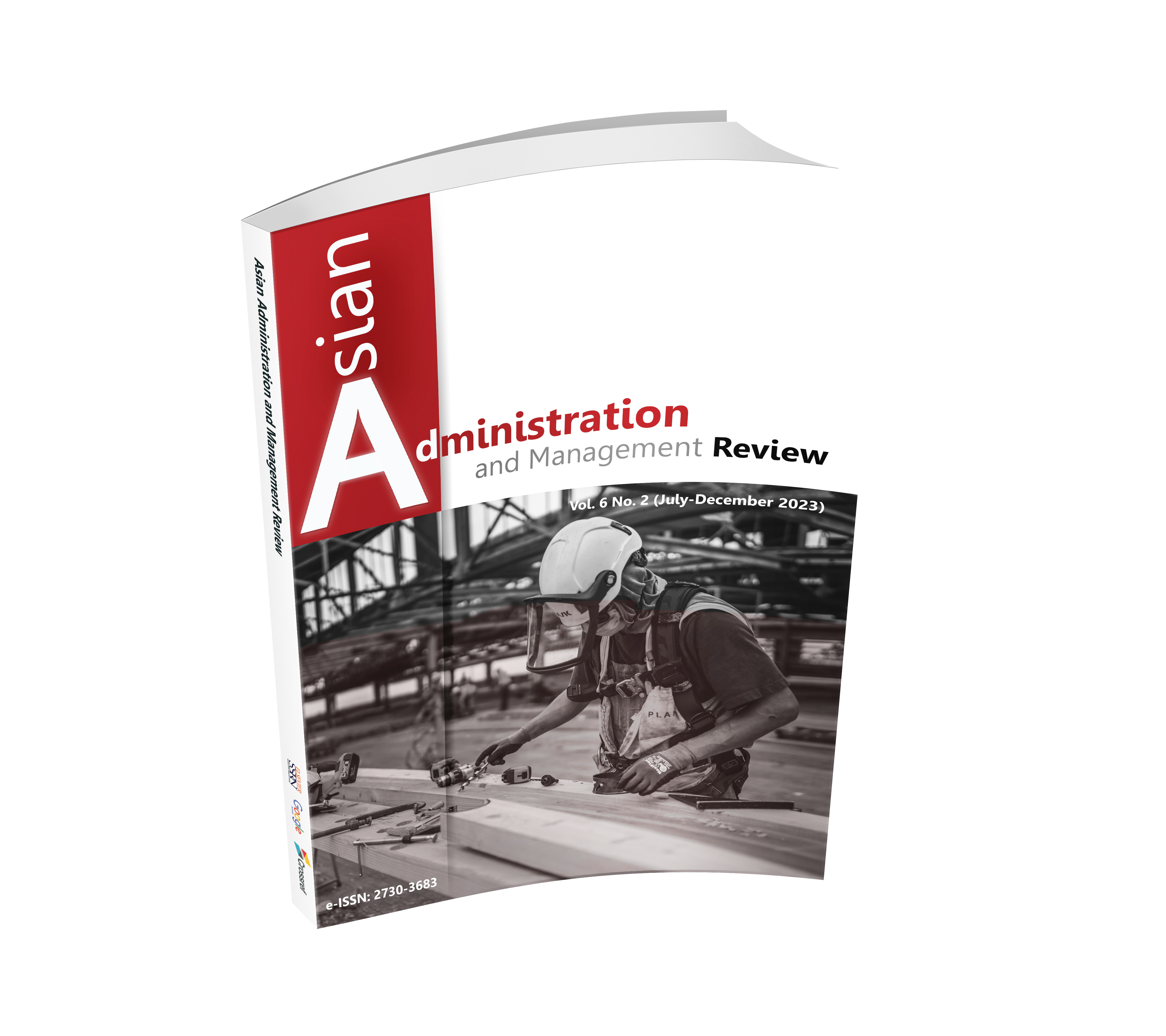CONSUMER PROTECTION MECHANISMS AND INFLUENCES IN ONLINE PURCHASES OF THAI HERBAL COSMETICS
DOI:
https://doi.org/10.14456/aamr.2023.20Keywords:
Thai Herbal Cosmetics, e-Marketing Mix, Consumer Protection, Online PurchasingAbstract
This research aimed for study of consumer protection mechanisms and influences in online purchases of Thai Herbal cosmetics. The 386 random samples were calculated followed W.G. Cochran method at confidence level of 95 percent. This exploratory research used questionnaire design, collected and analyzed data by statistic software package in frequency of percentage, mean and standard deviation. Hypothesis testing using t-test, one-way ANOVA and correlation Spearman’s Rho at 0.05 significant level with 0.95 confidence interval. The results were occupation; a demographic factor, site; an e-marketing mix and accessibility to information; a consumer protection have found to influence in online purchase of Thai herbal cosmetics. Research results also insisted on decorated herbal cosmetics website, link for more network, product must certify under FDA standard which was required most in buying. The purchases thru internet could provide convenient buying but did not gain much privacy benefits whereas consumers still beware of quality and review comments before buying.
Downloads
References
Anantnakarakul, S. (2021). Covid-19 & Thai Consumers: The Statistics Revealing Social Commerce Purchasing Behaviour during Covid-19 in Thailand. Retrieved from www.primal.co.th/social/social-commerce-thailand-usage/.
Bangkok Biz News. (2020). “Herbal Market” The Mainstream of Thailand’s Economy. Retrieved from www.bangkokbiznews.com/social/914569.
Buakong, V., & Boromtanarat, C. (2016). Factors Associated with the Consumer Protection Implementation of Village Health Volunteers in Nakhon Si Thammarat Province. Journal of Health and Health Management, 3(1), 48-62.
Chaiwiboolvech, R. (2018). Cosmetics and Beauty Market in the Age of Rushing. Retrieved from https://brandinside.asia/mkt-gantar-research-1/.
Chattaraj, D., Mazumder, R., & Lahiri, S. (2018). Buying Behaviour of Herbal Cosmetics by Women Consumers: An Exploratory Study in Kolkata. Indian Journal of Marketing, 48(5), 36.
Consumer Protection Act 1979.
Department of Science Service. (n.d.). Database to Promote and Enhance the Quality of OTOP Product. Retrieved from www.sptn.dss.go.th/otopinfo/index.php/en/knowledge/interesting-articles.
Food and Drug Administration. (2019). FDA Reveals Statistics on Surveillance and Inspection of Illegal Health Products Focused on Protecting Consumers’ Safety. Retrieved from https://oryor.com/media/checkSureShare/media_news/1748.
Food and Drug Administration. (n.d.). Permission for Cosmetics. Retrieved from https://cosmetic.fda.moph.go.th/permission-for-cosmetics.
Foundation for Consumers. (2013). FDA Reveals! 5 Dangerous Herbal Medicines Claiming Over the Counter Properties Not Registered Medicines. Retrieved from www.consumerthai.org/consumers-news/consumers-news/food-and-drug/1134-5-462.html.
Harnvanich, E., Wanichwecharungruang, S., Chandrachai, A., & Asawanonda, P. (2020). Market Potential Evaluation for Local Herbal Extracts Used in Skincare Through the New Product Development Process. PSAKU International Journal of Interdisciplinary Research, 9(2), 31-40.
Kalyanam, K., & Mcintyre, S. (2002). The E-Marketing Mix: A Contribution of the E-Tailing Wars. Journal of the Academy of Marketing Science, 30, 487-499.
Kasasa. (2021). Boomers, Gen X, Gen Y, Gen Z, and Gen A explained. Retrieved from https://offer.kasasa.com/exchange/articles/generations/gen-x-gen-y-gen-z.
Ministry of Public Health. (2016). National Master Plan Concerning the Development of Thai Herb 2017-2021. Nonthaburi: Ministry of Public Health.
Money and Banking Online. (2023). The Go-On Cosmetics Market after Covid-19 while Covid-19 Can’t Stop Beauty. Retrieved from https://moneyandbanking.co.th/2023/36035/.
Moongvicha, S. (2016). Creative Product Marketing Strategies in Herbal Cosmetics of Thai SME in Bangkok Metropolitan. PSAKU International Journal of Interdisciplinary Research, 5(1), 10-17.
National Statistical Office. (2022). Demographic Statistics Population and Housing. Retrieved from http://statbbi.nso.go.th/staticreport/page/sector/th/01.aspx.
Norasingha, P., & Buchitchon, S. (2020). Legal Problem and Appropriate Guidelines for Customer Protection: Case Study of Cosmetics Users. Pañña Panithan Journal, 5(2), 161-172.
Rainmaker. (2022). Overview and Trend of E-Commerce 2022. Retrieved from www.rainmaker.in.th/trend-and-statitic-ecommerce-2022/.
Schiffman, L., & Kanuk, L. (2004). Consumer Behavior. 8th ed. London: Prentice-Hall.
Soongsathitanon, K. (2019). Consumer Protection Proposal on Unfair Online Cosmetic Advertisements in Context of Consumer Information. Master of Science in Pharmacy Thesis, Naresuan University.
Thailand Consumers Council. (2022). Warning: Don’t be fooled. ‘Selling Drug’ in villages can be dangerous-not up to standard. Retrieved from https://www.tcc.or.th/18072565_phrae-story/.
Thailand Plus Online. (2023). Direction of Cosmetics after Covid-19. Retrieved from www.thailandplus.tv/archives/695901.
Thanisorn, R., & Byaporn, N. (2013). Marketing Strategies of Herbal Cosmetic Products: Thai and Imported Products. Journal of Economics and Behavioral Studies, 5(4), 242-251.
Thongchoete, S. (2015). Legal Problem Relating to Consumer Protection in Selling Goods or Services by Using Electronics Medi. Master of Laws Thesis, Sripatum University Chonburi Campus.
TNN Online. (2023). Cosmetics Market Grows after Covid-19 Support Thailand Earn 100 Billion Incomes. Retrieved from www.youtube.com/watch?v=A4OcQ2EtKys.

Downloads
Published
How to Cite
Issue
Section
License
Copyright (c) 2023 Authors

This work is licensed under a Creative Commons Attribution-NonCommercial-NoDerivatives 4.0 International License.











.png)


